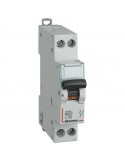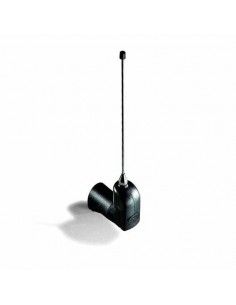- ELECTRICAL NEWS
- 0 likes
- 5155 views
- 0 comments

TV antenna system: the importance of choosing quality components
The configuration of a TV antenna system requires care and precision, especially in the choice of products to use. Using high-quality components and placing them correctly is crucial to achieving satisfactory output. An error at this stage could in fact lead to a loss of quality of the television images.
How to guarantee an optimal TV signal
The television signal coming from the antenna can suffer from dispersion, especially when it has to serve multiple televisions. Fortunately, it is possible to minimize this dispersion, or even eliminate it, through the correct use of certain devices.
What are shunts, dividers and amplifiers in a TV antenna system
Branches, splitters, amplifiers and switchboards are fundamental components to guarantee a high-quality television signal. But what exactly do these components do and how are they used in a TV antenna system? Let's find out together, category by category:
✔️ Derivators and dividers
The shunts and dividers are essential for distributing the television signal from the antenna to the various televisions, guaranteeing a stable signal to each of them.
✔️ Amplifiers
Amplifiers, on the other hand, have the task of strengthening the initial television signal, preventing losses and ensuring high image quality.
✔️ Switchboards
Switchboards represent the heart of a TV antenna system, managing the distribution of the signal between cables, amplifiers, shunts and dividers.
For optimal installation, it is therefore necessary to know and use these components appropriately. Only in this way can we guarantee the best possible viewing experience.
Difference between divider and differentiator
In the field of design, construction and construction of a TV antenna system, we often talk about two fundamental terms: divider and shunt. But have you ever wondered what the difference is between these two devices? This is not an insignificant difference, far from it.
The use of the divider and the shunt in the TV system
The use of the divider or shunt affects the type of db productivity that the antenna cable can offer. This difference can then positively or negatively influence the visual performance of your television channels, depending on how they are used and the instructions followed during installation.
What is a differentiator and when to use a divider
Let's now go into detail to better understand what a differentiator and a divider are and how to decide when to use one or the other. By knowing these two components better, you will be able to choose the solution that best suits your TV reception needs.
The Role of a Divider
A divider is nothing more than a device that performs a key function in the transmission of television signals. It divides the signal flow from a single source and distributes it across the various lines. The distribution occurs proportionally to the number of outputs, thus guaranteeing equal signal loss for each line.
Position and Assembly of the Divider
The divider is usually mounted inside an inspection box in your home. This position allows you to intervene easily in the event of a possible breakdown or other needs. Maintenance and repairs thus become more simplified.
Divider connection
The divider has an input connection, also called "IN", to which the main antenna cable must be connected. As shown in a demonstration photo, the divider also has several output sockets, usually seven in number, connected to cables running to the various TVs. This ensures equal signal dispersion between all receivers.
When to use a shunt
To understand if and when you need to use a shunt, it is essential to understand its functionality and how it can be used. A shunt carries out the task of taking the signal from the main line and directing it towards the various branches, a process which at first glance may seem identical to the operation of a divider. However, there is an important distinction.
The difference between differentiator and divider
The main difference between a shunt and a divider lies in the structure and internal functioning of the two components. As is evident from the demonstration photo, the shunt has an input connection (called "IN"), to which the main cable is connected. Immediately after, you will find the output connection (called "OUT"), from which a cable can be sent that will have less dispersion than the other four outputs that will be redirected to the various television sets.
Use of the shunt in a television system
A divider can be connected to the shunt output cable to further disperse the signal to multiple TVs. This makes the shunt a very useful component, especially when you need a strong, high-quality signal. Usually the shunt is installed outside, for example in the common areas of a condominium to conduct the signal to multiple residential units.
Adding a Cable: The Secret to Not Losing the Signal
It often happens that we are asked the question: how to split an antenna cable to use another television in a different room? The answer is not as simple as it might seem. In fact, the choice could fall on the simple idea of extending the existing antenna cable, a solution which, however, as we will see, can create more problems than benefits.
The Dilemmas of Antenna Cable Extension
It is important not to be fooled by the fact that, in the environment chosen for installing the new television, there is already an antenna cable used for a different TV. In fact, simply extending the cable, perhaps replacing a direct socket with a pass-through one, or installing a divider, will almost certainly lead to a deterioration of the signal. As a result, your TV channels may not display clearly.
The Best Alternative: Install a Shunt
If the cable extension presents problems, what could be the best solution? The most effective advice is certainly to install a shunt upstream of the system, i.e. where the antenna enters the house. This method allows you to lose less DB on the system, thus guaranteeing the reception of a quality signal, as explained in the previous paragraph.
Conclusions
In conclusion, splitting an antenna cable may seem like a simple operation, but it requires attention and specific skills if you want to guarantee the best signal quality. Installing a shunt upstream of the system is the most suitable choice to avoid losing the signal and enjoy clear vision on your televisions.







Comments (0)